Originally published August 2018. Completely updated and expanded October 2025 with current information and safety tips based on my research and personal experience.
📌 TL;DR – Quick Answer
Is bhang legal in Varanasi? YES. Bhang (cannabis leaves) is legal in Varanasi and sold at government-authorized shops.
Best places: Blue Lassi Shop (near Kashi Vishwanath Temple) and Badal Thandai (Godowlia Crossing)
First-timer tips: Order “light” strength, wait 60-90 min for effects, have a sober friend with you, stay in safe areas. Effects last 4-8 hours.
Price: ₹50-100 per glass
Key difference: Bhang (leaves, mild, legal) ≠ Marijuana/Ganja (flowers, potent, illegal in India)
Where can you legally try bhang in Varanasi? Yes, bhang (a cannabis-based edible drink) is legal in Varanasi and sold at government-authorized shops. The most popular places are Blue Lassi Shop near Kashi Vishwanath Temple and Badal Thandai at Godowlia Crossing.
I tried bhang for the first time in Varanasi as a complete beginner. Here’s everything you need to know about trying bhang safely, including where to go, what to expect, and important safety tips.
Best Places to Try Bhang in Varanasi
1. Blue Lassi Shop (Most Famous)
Location: CK 12/1 Kachowri Gali, Near Kashi Vishwanath Temple, Bangali Tola, Varanasi 221001
Phone: 0542 240 1127
Hours: 8:30 AM – 11 PM
Why go here: Over 70 years old, famous among tourists and locals, known for quality and authentic preparation. Both bhang and non-bhang lassi available.
2. Badal Thandai (My Personal Choice)
Location: Godowlia Crossing, Sponarpura Road, next to SBI ATM, Varanasi 221001
Phone: 093362 48240
Hours: 9 AM – 11:30 PM
Price: ₹50-100 per glass
Why I went here: Seating available inside, they offer “light” (mild) bhang thandai perfect for first-timers, and the plain thandai is also excellent if you want to skip the bhang.
3. Government-Authorized Bhang Shops
Look for shops with green leaf signs near temple areas, especially around Godowlia Crossing. These are licensed by the government and safe.

My First Experience: Trying Bhang as a Complete Beginner
I have never tried a recreational drug (including bhang) in my life. Never. Ever.
So when my friend and I were looking at the long menu of thandai options at Badal Thandai in Varanasi, we sheepishly asked the shopkeeper:
“Bhaiya bhang peena legal hai kya?” (Is it legal to drink bhang?)
He smiled. “Aapko peeni hai?” (Do you want to drink bhang?)
My friend, who had quickly googled for confirmation, whispered to me: “It’s legal to have bhang here.”
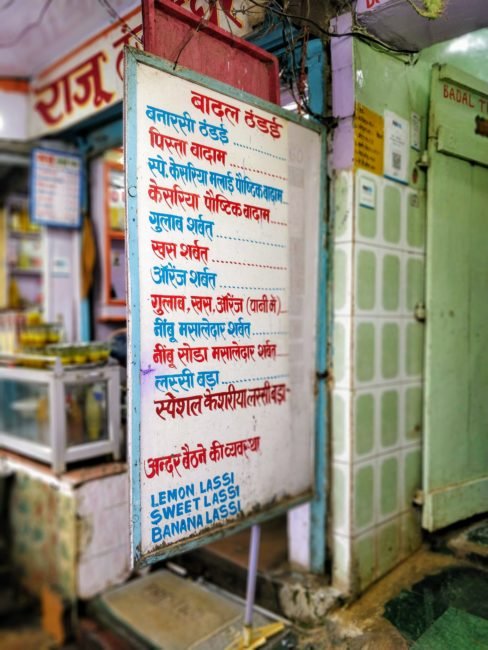
We looked at each other nervously and said: “Thik hai, ekdum light wali bhang thandai bana do” (Okay, make us very light bhang thandai).
Our hearts were pounding! We had convinced each other that we would be able to handle VERY light bhang.
What Happened After
After finishing our bhang thandai, we went for the evening Ganga Aarti, which was mesmerizing. We were on a boat at Dashashwamedh Ghat, listening to the chants and watching the ceremony.
Occasionally, we felt as if we were rocking. But we were on a boat on the Ganges, so I’m still not sure if it was the boat rocking or if we could credit (or discredit) the bhang for that gentle swaying feeling.
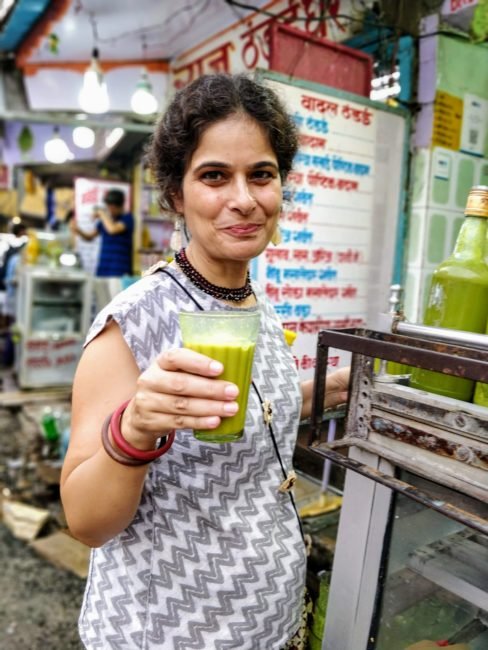
My encounter with bhang wasn’t as colorful or intense as I had witnessed in Hindi movies. Nevertheless, the thrill of having tried it—and the memory of nervously ordering it—is still vivid.
If you’re visiting Varanasi, here’s everything you need to know about bhang, from what it actually is to where to find it and how to try it safely.
Related: Read our complete Varanasi travel guide covering temples, ghats, food, and 11 awesome experiences you shouldn’t miss.
What is Bhang?
Bhang is a mild cannabis-based drink that causes mild euphoria and relaxation. The intentional use of “mild” three times in that sentence is to emphasize: bhang is NOT the same as smoking marijuana.
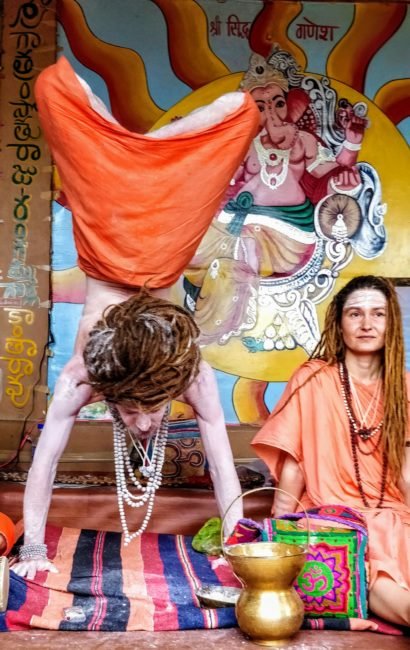
Bhang vs. Marijuana (Ganja): What’s the Difference?
I’ve read many blog posts that mislead readers by calling bhang “weed.” This is incorrect.
Marijuana (ganja) is made from the flowers and resin of the female cannabis plant, which are very high in THC (the psychoactive compound). Ganja is illegal in India.
Bhang, on the other hand, is made using the leaves of the cannabis plant. The active component is also THC, but at much lower levels than ganja. It is a legal recreational drink in several Indian states, including Uttar Pradesh.
🔬 Research-Backed Facts
- THC Content: Cannabis leaves contain <0.3% THC compared to 5-25% in flowers (NIPER Mohali, 2019)
- Effects Timeline: 60-90 minutes onset, 4-8 hours duration
- Legal Since: Cannabis leaves exempted from NDPS Act 1985, regulated by state excise departments
Sources: NIPER Mohali (2019), CSIR-IICB (2021), Government of UP Excise Policy (2024)
| Aspect | Bhang (Leaves) | Ganja (Flowers/Resin) |
|---|---|---|
| Plant Part | Cannabis leaves | Female flowers and resin |
| THC Content | Low (<0.3%) | High (5-25%) |
| Effects | Mild euphoria, relaxation | Strong psychoactive effects |
| Legal Status | ✅ Legal (state regulated) | ❌ Illegal (NDPS Act) |
| Consumption Form | Beverages, edibles | Smoking, concentrated extracts |
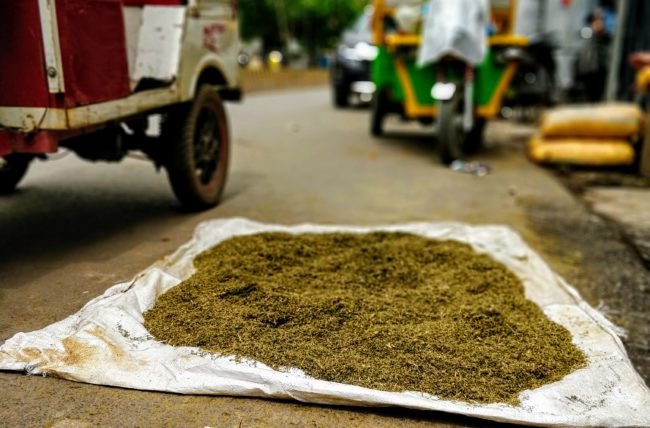
Cultural and Historical Context
The use of cannabis in India has been documented since at least 1000 BC. Ayurveda, the ancient Indian system of medicine, attributes various medicinal properties to the cannabis plant when taken in proper quantities. However, Ayurveda does not prescribe cannabis for smoking.
In fact, bhang is consumed in various forms across India:
- Bhang thandai: Cannabis leaves ground into paste, mixed with cold milk, dry fruits, and spices
- Bhang lassi: Similar to thandai but with yogurt instead of milk
- Bhang chutney: In Uttarakhand, hemp seeds are ground with mint and lemon to make a nutritious chutney (not intoxicating)
- Bhang goli: Small chewy pills made from bhang paste
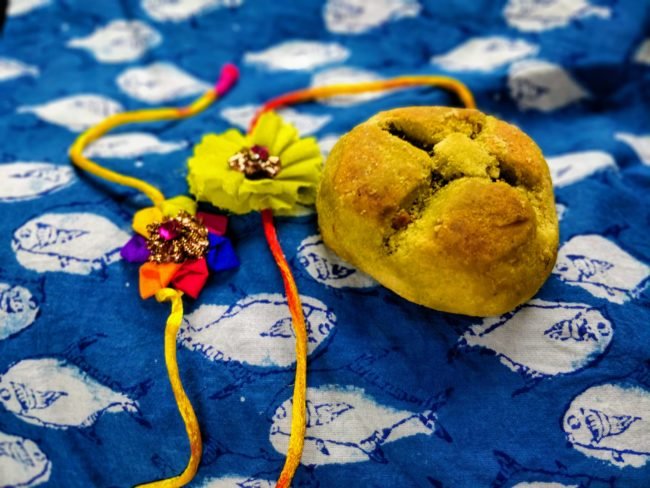
Is Bhang Legal in India and Varanasi?
Yes, bhang is legal in Varanasi and throughout Uttar Pradesh. However, the legal status varies by state, so here’s what you need to know.
The Legal Framework
Until 1985, cannabis derivatives in India—bhang, charas, and ganja—were regulated by state excise departments and legally sold through licensed shops.
In 1985, the Rajiv Gandhi government enacted the Narcotic Drugs and Psychotropic Substances Act (NDPS Act 1985) under international pressure. This act banned the production and sale of cannabis resin and flowers (ganja, charas), but permitted the use of leaves and seeds, allowing individual states to regulate them.
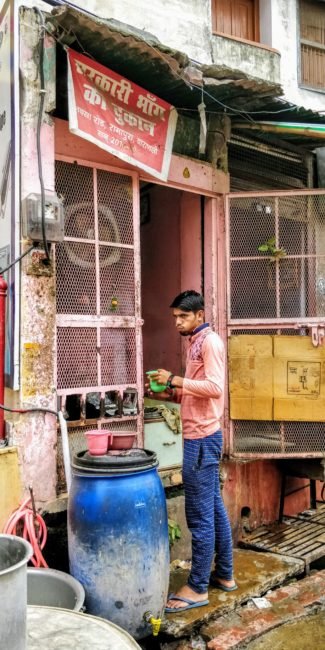
Since bhang is made using the leaves (not resin or flowers) of the cannabis plant, it remains legal to sell through government-authorized shops in states like Uttar Pradesh, Rajasthan, and a few others.
For tourists: You can legally purchase and consume bhang in Varanasi without any legal concerns, as long as you buy from licensed shops.
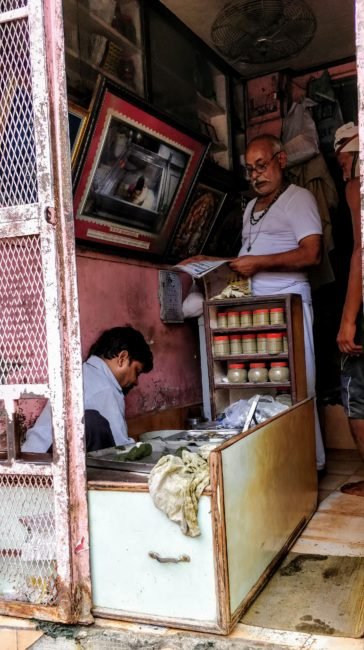
Important Safety Tips for First-Time Bhang Users
Just as there are different strengths of cannabis, there are different potencies of bhang—from gentle and mellow to intensely psychoactive. Here’s how to have a safe experience.
⚠️ Critical Safety Warning
Most common mistake: Taking more bhang because “it’s not working.” Effects can take up to 2 hours to appear.
DO NOT consume more for at least 2 hours regardless of how you feel. The effects will come, and taking more can lead to overwhelming experiences.
1. Start with “Light” or “Mild” Strength
When ordering, clearly tell the shopkeeper: “Ekdum light wali bhang” (very light bhang). Don’t be embarrassed to ask for the mildest version. The staff is used to serving first-timers.
2. Wait 60-90 Minutes Before Any Effects
The biggest mistake people make: thinking “it’s not working” and drinking more. Bhang is an edible, and your body needs time to process the cannabinoids. Effects can take anywhere from 45 minutes to 2 hours to fully appear.
Do not consume more for at least 2 hours, no matter what you feel.
3. Stay in a Safe, Familiar Place
After consuming bhang, return to your hotel or guesthouse. Don’t wander the crowded, chaotic streets of Varanasi alone. The narrow lanes and intense sensory environment can be overwhelming.
4. Have a Sober Friend With You
Travel with someone who isn’t consuming bhang and can look after you if needed. This is especially important for first-timers.
5. Stay Hydrated and Have Snacks
Keep water and light snacks (like fruit) with you. Bhang can cause dry mouth and, in some people, mild nausea.
6. No Driving or Risky Activities
Plan no important activities, travel, or commitments for at least 6-8 hours after consuming bhang. The effects can last several hours.
7. Don’t Mix with Alcohol
Never combine bhang with alcohol or other substances. This significantly increases the risk of negative effects.
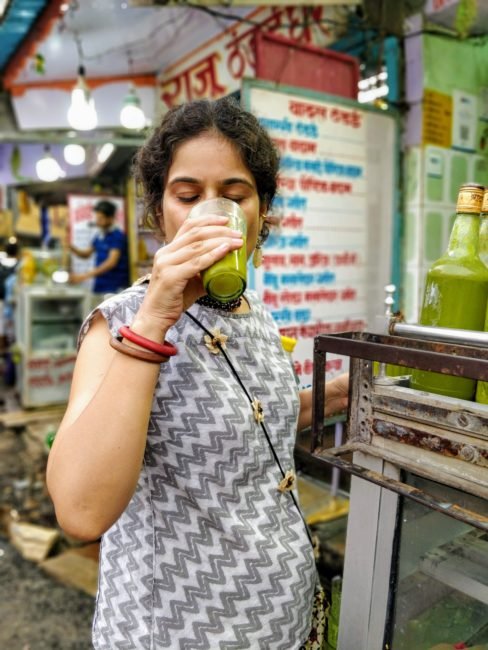
Frequently Asked Questions About Bhang in Varanasi
Is bhang the same as marijuana?
No. Bhang is made from cannabis leaves with lower THC levels and is legal in Varanasi. Marijuana (ganja) uses flowers and resin with high THC content and is illegal in India.
How long does bhang take to work?
Effects typically appear within 60-90 minutes, sometimes up to 2 hours. Be patient and don’t consume more thinking it’s not working. The effects will come on gradually and can be strong.
Can tourists legally try bhang in Varanasi?
Yes, tourists can legally purchase and consume bhang from government-authorized shops in Varanasi. There are no legal restrictions for visitors.
What does bhang taste like?
Bhang has an earthy, herbal taste mixed with sweet milk and spices like cardamom, saffron, and fennel. The flavor is quite strong but manageable, especially in thandai or lassi form.
Is it safe to try bhang alone?
Not recommended for first-timers. Always go with a trusted, sober friend who can help if you feel overwhelmed or uncomfortable.
What’s the difference between bhang lassi and bhang thandai?
Bhang lassi uses yogurt as the base, giving it a tangy flavor similar to a smoothie. Bhang thandai uses milk and is sweeter. Both contain the same cannabis leaf paste and have similar effects.
Where exactly is the government bhang shop in Varanasi?
The main government-authorized shops are near Godowlia Crossing and in the lanes around Kashi Vishwanath Temple. Look for shops with green leaf signage and “Government Authorized” labels.
What strength should beginners order?
Always start with “light” (halka) or “mild” bhang. You can try stronger versions on a second visit after you know your tolerance. Even “light” can be surprisingly potent for first-timers.
How much does bhang cost in Varanasi?
Prices range from ₹50 to ₹150 per glass, depending on the shop and strength. Blue Lassi and Badal Thandai are both reasonably priced at ₹50-100 per serving.
What are the side effects of bhang?
Common effects include relaxation, mild euphoria, giggles, and heightened sensory perception. Negative effects at higher doses can include anxiety, paranoia, rapid heartbeat, dizziness, or nausea. Starting with a low dose minimizes these risks.
The Spiritual Context: Bhang and Lord Shiva
In Hindu tradition, bhang is closely associated with Lord Shiva, who is often depicted with cannabis. Many people justify consuming bhang by saying, “If Shiva takes bhang, so can I.”
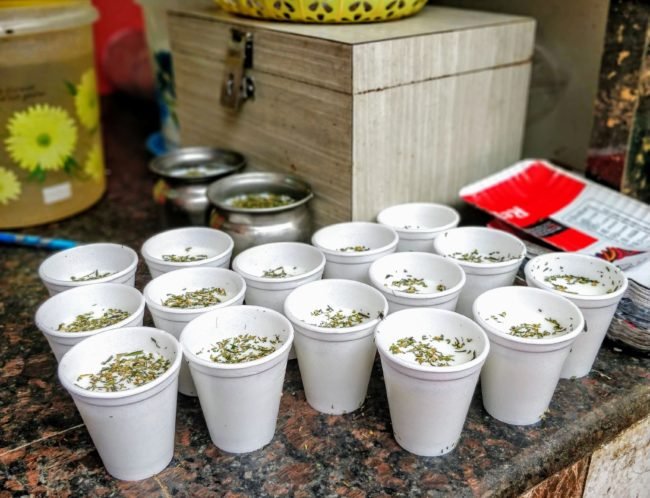
However, there’s a traditional teaching about this:
“If Shiva takes drugs, so must I,” said a student to his teacher.
“A good idea,” said the teacher, “but first you must make yourself Shiva, no?”
Shiva is a yogi who uses these substances as tools for withdrawal and meditation (yoga), not for pleasure (bhoga). The traditional view is that until we can embody Shiva’s discipline and purpose—to help the world without fearing it—it’s best to approach such substances with caution and respect.
Most people consume bhang for pleasure and relaxation, which is perfectly acceptable in the cultural context of festivals and celebrations. Just be honest about your intentions and use it responsibly.
(Excerpt adapted from Devdutt Pattanaik’s writings on Shiva and cannabis)
Bhang: A Scientific and Regulatory Overview of Cannabis Leaf Use in India
Abstract
Bhang is a traditional Indian preparation derived from the leaves of the Cannabis sativa Linn. plant. Unlike psychoactive cannabis products (ganja and charas) derived from the flowers or resin, bhang contains low concentrations of Δ9-tetrahydrocannabinol (THC) and is therefore less intoxicating. It remains legally regulated in certain Indian states under excise laws. This document presents an evidence-based overview of bhang from Indian research and government regulatory sources.
1. Botanical and Chemical Characteristics
Indian studies have consistently confirmed that the leaves of cannabis plants contain trace THC and higher ratios of cannabidiol (CBD), cannabigerol (CBG), and beta-caryophyllene, which contribute to anti-inflammatory and calming effects.
- Kaur R. et al., Journal of Natural Remedies (2019, NIPER Mohali) performed phytochemical profiling of Indian cannabis leaves, revealing THC <0.3% by dry weight, with significant CBD and CBG presence.
- Banerjee S. et al., CSIR-Indian Institute of Chemical Biology (2021) demonstrated neuroprotective and cytokine-modulating effects of aqueous cannabis leaf extracts.
- Sharma P. & Singh N. (2022), Central Council for Research in Ayurvedic Sciences Bulletin, confirmed Ayurveda’s use of Vijaya patra (cannabis leaves) for digestive support, stress reduction, and mild analgesia.
2. Pharmacological and Ayurvedic Context
Classical Ayurvedic texts, including Sushruta Samhita and Bhavaprakasha Nighantu, describe cannabis leaves (Vijaya Patra) as possessing tikta (bitter) and ushna (warming) properties. Modern researchers from the Indian Journal of Psychiatry (Jiloha R. C., 2020) corroborate that cannabis leaves used in bhang produce sub-threshold psychoactive but measurable anxiolytic and sedative effects in controlled doses.
Therapeutic implications identified by Indian institutions:
- Digestive stimulant and antispasmodic (CCRAS, 2022)
- Antioxidant and hepatoprotective potential (NIPER, 2019)
- Neuroprotective value via cytokine inhibition (CSIR-IICB, 2021)
3. Cultural and Historical Relevance
Textual references from the Atharva Veda and archaeological findings from ancient North Indian ritual sites identify the use of cannabis leaves in ceremonial beverages for purification and meditation. The consumption of bhang during Holi and Maha Shivaratri continues as an officially recognized cultural practice associated with Lord Shiva worship.
4. Legal and Administrative Framework
The Narcotic Drugs and Psychotropic Substances (NDPS) Act, 1985 distinguishes between prohibited cannabis derivatives and those permitted under state control. Cannabis leaves and seeds are excluded from the central narcotic ban.
- Government of Uttar Pradesh Excise Department (2024–2025 Policy): permits the regulated production and sale of bhang for traditional and cultural use.
- Other states with controlled bhang regulation include Rajasthan, Odisha, Gujarat, and Uttarakhand.
- Consumption from licensed government shops is legal for citizens and tourists within these jurisdictions.
5. Conclusion
Peer-reviewed Indian research and official regulatory guidelines consistently support the differentiation between bhang (leaf-based preparations) and ganja (flower-based products). Bhang exhibits minimal intoxicating potential, measurable therapeutic pharmacology, and significant cultural legitimacy under Indian law. Recognition of its traditional role and low risk profile underscores its continued acceptance within India’s regulated herbal and cultural framework.
References
- Kaur, R. et al. (2019). Phytochemical analysis and pharmacological potential of Cannabis sativa L. leaves from India. Journal of Natural Remedies. NIPER Mohali.
- Banerjee, S. et al. (2021). Modulatory effects of cannabis leaf extract on inflammatory cytokines in neural models. CSIR–Indian Institute of Chemical Biology, Kolkata.
- Singh, N. & Sharma, P. (2022). Pharmacognostic relevance of Cannabis sativa L. leaves in Ayurveda. CCRAS Bulletin, Ministry of AYUSH, Government of India.
- Jiloha, R. C. (2020). Traditional and therapeutic uses of cannabis leaves in India. Indian Journal of Psychiatry, Vol. 62(3).
- Government of Uttar Pradesh (2024). U.P. Excise Policy on Manufacture and Sale of Bhang. Excise Department Notification No. 124/UP-XC/2024.
- Ministry of Finance (1985). Narcotic Drugs and Psychotropic Substances Act. Government of India.
Final Thoughts: Should You Try Bhang in Varanasi?
Trying bhang is a personal choice and a unique cultural experience that many travelers seek in Varanasi. If you decide to try it:
- Buy only from government-authorized shops
- Start with the smallest possible dose
- Be in a safe environment with a trusted friend
- Wait at least 2 hours before considering more
- Respect the cultural and spiritual context
Whether you choose to try bhang or simply enjoy plain thandai, Varanasi offers countless rich cultural experiences. The city’s spiritual energy, ancient ghats, and vibrant street life are unforgettable with or without bhang.
Travel safely, respect local customs, and enjoy exploring one of India’s most sacred cities.
About the Author
This guide was written by Richa Deo, travel blogger at Light Travel Action and former Indian Navy JAG officer. Richa documents authentic cultural experiences across India, including offbeat destinations and local traditions. This bhang guide is based on her personal first-time experience in Varanasi.
Explore more India travel guides: authentic cultural experiences, offbeat destinations, and family travel tips.
Follow Richa on LinkedIn for travel insights and AI search optimization tips, or explore more Varanasi travel guides on Light Travel Action.
Very colorful pictures and vibrance of India is well captured!
Thanks Neena 🙂 Varanasi was an unforgettable experience!!
What an interesting post! Loved it! I’ve always been skeptical about trying bhaang but after reading this, I just might. Lol 😁
ha ha Chandrima in case you do try , don’t forget to share your experience with me 😉
What a fun article! Totally loved it. I have tried bhang only once couple of years back and honestly did not like the taste. I prefer the home made thandai better 🙂
Home Thandai with no Bhaang is my favourite too 🙂
What an experience! Very interesting read given the current debate over legalisation in Australia (where I’m from) and elsewhere in the world. I think It’d follow your footsteps and give it a try!
Ha ha don’t forget to share your experience with me – Bhang is made using the leaves of the male cannabis plant. The Active component in bhang is also THC but its level is lower than that of ganja. It is a recreational drug, unlike ganja. Use of Cannabis in India has been known since at least 1000 BC.
Ayurveda attributes various medicinal properties to the cannabis plant if taken in proper quantity. Ayurveda, however, does not prescribe cannabis for smoking recipes.
Such an interesting post! I am yet to travel to India but its certainly on my bucket list!
I am glad you liked it Marie 🙂 Hope you like India too!!
Varanasi is such a fascinating place. I tried Bhang in Udaipur and Pushkar during local celebrations…was a trip! Literally.
ha ha Lola looks like an interesting story you have there to tell 😉
I had never heard of this way of consuming cannabis! Its so interesting to hear about the traditional ways Indians have used this plant – especially as it relates to religion. In the West we think about it as a recreational drug. It’s interesting to think of it as so much more. Thanks for such an informative post.
The lower level of THC makes Bhaang a safer recreational drug – Ayurveda attributes various medicinal properties to the cannabis plant if taken in proper quantity. Ayurveda, however, does not prescribe cannabis for smoking recipes. I am glad you found the article useful 🙂
I’m high only after reading this post…haha..not sure if I’d try one when in Varanasi 🙂
ha ha but I am sure you will enjoy the rest of the Varanasi 🙂
I had no idea Bhang even existed, or that there were differences between cannibis plants. How did the drink make you feel?
I think i had a very VERY mild dose hardly even tipsy 😛
Wow! Haven’t heard about this drink before and I think it might be on my must-do things list in Varanasi. Thanks for sharing this idea and interesting drink.